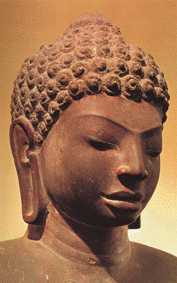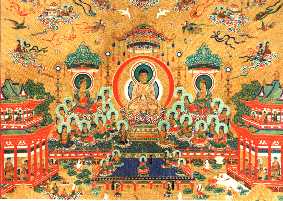
Update jeudi 06 avril 2006 12:09
What is Buddhism?

Copyright © S‚dhana
(The underlined words give access to the other pages, please , do not forget it !)
Since near century, by means of the educations of big personalities: Ajahn Chah, Ledi sayadaw, vťn. Bouddhad‚ssa, Dhammap‚la, Nyan‚ponika, Nyan‚tiloka, W. Rahula, D.T Suzuki, T. Deshimaru, Kalou rinpochť and XIVŤ Dalai Lama... The Buddhism made numerous emulators in West and one sees gradually basing himself centres in the multiple obediences.
In West, the Buddhism, by the philosophy which it conveys, can serve as platform in the western religious practices, some Christianity, Islam, etc. and coexist with these. He inclined particularly to the tolerance by the correct understanding of the human beings, the phenomena and the things.
vťn. Shinjin Robert Brandt-Diťny insist to underline that it tries(feels) the most profound respect for the fervour and the devotion of the populations native Buddhists for whom it is an ancestral religion, anchored in the collective unconscious.
Stemming from a tradition more than bi-millennium, the Buddhism, although one can consider it as a religion grouping almost together(including almost ) a billion followers, shows to be a fundamentally essential philosophy of the Life.
In
VI-th s avenue. J-C, prince Siddh‚rta,
confronted brutally with the daily spectacle of the suffering, took the firm
resolution to bring to his fellow men remedies to this one. This making(doing),
having tried different methods, it(he) reached the Illumination and was called Buddha
or the Awake(sharp). " If the rope of the cythar is too much
tightened(stretched out), she(it) breaks, if it is too cowardly, she(it)
produces no sound. To resound at best, she should be in the middle
". Of India which was its cradle, the Buddhism spread some Cashmere in
Japan, by way of the Tibet and Indonesia, covering so all the part(party) is
from Asia.
Do not forget that the Buddhism became a religion which towards the 2d p. J-C. Indeed, the theravadine tradition or ancient was much more a philosophy of life, passed on by the monks and applied strictly by them in convents. It was so the unique privilege of a clergy worried of immortalizing the original educations of the Buddha, realized man who was on no account either a god, or a divinity, by defending itself on the contrary.
As in any spiritual succession, dissensions in the monastic order began to demonstrate themselves and, between a certain laxness and an almost fanatical fundamentalism both condemned persons by Buddha himself, a tendency (that of the mah‚sanghika) was born; tendency in which Sangha, reserved until then only for the monks, could get bigger to the laymen, the Mah‚sangha. These less evolved spiritually than the monks need supernatural, miracles, superstitions to believe, to support the applications of the moral and philosophic principles, inheritances of the monastic life.
It is from this moment, that the Buddhism, of initial philosophy, Way towards the Wisdom that it was, is going to become religion. According to its territorial extension, it acclimatizes local faiths by setting up, in divinities, the upholders of the answers to the metaphysical questions emitted(uttered) by the common run of people. One sees then being outlined a Buddhist pantheon, blooming of divinities more terrifying and wrathful than openly peaceful, images intended to strike the imagination of the believers ands regular customers).
Let us draw up a short summary of the different forms of the Buddhism such as they appear at present :
Three Vehicles or big Buddhist Traditions
Here, it is major to dissipate any misunderstanding, nobody is superior to the others, they are different, correspond to different geographic regions, in different periods, also in different levels of consciousnesses in consideration of the exempt, often late Education, and strongly tinged with heterodox traditions in the initial Buddhism, or previous (Hinduism) or later(posterior) (Lamaism, BŲn, animism, shamanism... Who can on no account refer to the Buddhism).

1 - Small Vehicle or Thťra-v‚da of the former)(ancient) says also Hinay‚na, is the direct education of living on the Buddha. It is dedicated to the fact of reaching, egocentricly, incidentally, at the stage of Arhat or Saint. So having reached the Wisdom or the Awakening, one is Prateyka-Bouddha or Buddha for one. Thťra-v‚da is spread in the Sri Lanka, in Burma, in Cambodia, in Laos, in Thailand, little in India (more Hindu than Buddhist, contrary to what one would be tried to think). Among the soŻtras big of Hinay‚na, are Metta and Mah‚-mangala suttas. It represents, in percentage of the totality of the populations autochtonous Buddhists, a 35 %

2 - Big Vehicle or Mah‚y‚na, later(posterior) of more than two centuries than the death of the Buddha, is he on the other hand, more altruistic and aims to exceed this absolute collection, egocentric person and solitary person of the Wisdom, lauding the fact that having reached the Awakening, one helps the biggest number of its fellow men to reach there, by giving up the entry in Nirv‚na (definitive liberation of the human shape) to accept a human revival, in the form of Bodhisattva, in this altruistic purpose. This vehicle contains ViÍtnam, China, Korea, Japan, with among the most known schools: Ch'an, the differents Zen (Obaku, RinzaÔ, Soto, Unmon), Korean Chogye, JŰdŰ ShŻ and JŰdŰ ShinshŻ lauding the Amitabha's pure Earth, the Nichiren ShŻ and ShŰshŻ, the TendaÔ, the HossŰ, the Kegon, the ReiyukaÔ, among hundreds of schools, traditions and "sects" ensuing from Mah‚y‚na. As for him, the percentage represents 62 % of the native population Buddhist.
3 - Being a part integral of Mah‚y‚na due to its bodhisattvique end, but differing all the same sharply up to the point to make a third vehicle different from it, we find the adamantin Vehicle (coming from the diamond, intended to cut the ego) and tantrique that one calls(mentions) mainly Vajray‚na, additionally Tantray‚na and same Mantray‚na (defining itself as the Vehicle which, according to the propagated tradition, would allow by the Practices or Tantras to reach Nirv‚na in a single existence). Heir of the practices of the Hinduism and the remainders BŲnpo, pre-existent locally and which do not belong to the original Buddhism expressed by Buddha, practices adapting easily multiple deities of a late Buddhism, he is particular in the Tibet, with some extensions to Bouthan, Zanskar, Ladakh, Mongolia; One finds there certain aspects ťsotťriques marked in the Japanese sect Shingon (school of the True Word, based by Kobo Daishi or Kukai in 806).
Vajray‚na said " Tibetan Buddhism " is at present the shape the most spread(diffused), wide-spread and the most run about the Buddhism in West, well before even the Zen. The percentage does not exceed the 2 %, distributed on several countries and especially divided into 4 schools and some sub-schools, representing each of them that a tiny part of the total percentage of the population Asian native Buddhist.
As confirmed it very vťn. Kalou Rinpochť, and as the vťn Dhagpo rinpochť has just repeated it recently, both eminent authentic masters:
" It is imperative to have robust basic notions of the Buddhism, even excellent, that it is of Thťrav‚da and Mah‚y‚na, before to want or even to manage to interfere in the maze of the practices Tibetan tantriques. "
To end on the various vehicles, one could say that at present is daylight a tendency being similar to a vehicle which would gather the aforesaid three in the Essentiality of Buddha's Teachings (without recommendation nobody at any school, because the evidence of this fundamental education is as true for a Tibetan, as for a Sri Lancan, a Thai, Japanese, French, Swiss, Belgian, Quebecer...) namely :
- Bouddhay‚na, similar to Ekay‚na, the unique Path imported by Bodhidharma, the 28-th successor of the Buddha, in China. This one would base itself on the knowledge and the application, with the active altruistic condolence in the daily life, three Confidences, four Essential Propositions and four Buddhist Wishes, five Rules, six Stages of the practice, seven Factors of Awakening, Noble Eightfolds Path , ten Perfections, eleven Virtues ..., the bases common to three aforesaid vehicles. The soŻtra the most read and recited by Mah‚y‚na and by Bouddhay‚na is Mah‚ PrajŮ‚-p‚ramit‚-Hridaya soŻtra or soutr‚ of the Supreme Wisdom essence.

The spirit of the Buddhism expresses himself differently according to the different aspiration of the traditions Thťrav‚da, Mah‚y‚na, Vajray‚na of whom he arises and from countries where they are practised. Nevertheless, the Education fundamental Buddhist: the Way of the Buddha or Bouddhay‚na, whatever school it is, is inevitably connected with the Four Noble Essential Propositions, the principles even of the Law of Causality, namely:
1 - Omnipresent existence of the dissatisfaction or suffering (more compatible term with Dukkha) - everything is suffering in this world,
2 - Origin or causes of the dissatisfaction due to the desire / affection - the origin of this suffering is our ignorance of its origin and its causes, namely the desire and the affection,
3 - Cessation of the dissatisfaction by releasing itself from desires / affections - to deliver itself from this suffering engendered by the desire, a single remedy: fight(dispute) this ignorance by reaching the knowledge of the mechanisms of this one to abandon it,
4 - Path leading to the cessation of
the dissatisfaction by the fulfillment of the eight stages resulting in the
total Liberation or Ultimate Wisdom; it is Noble Octuple Sentier or the Way of
the Buddha. - the road to reach the Liberation of the Suffering or Nirv‚na is
the correct application of the different spiritual stages.
( The term used by dissatisfaction denotes more the character of imbalance than
that of suffering, which is more a change, a bruise)
According to this unchanging law, the effect arises from causes the actors of which we are. It is so necessary us to reach the Awakening or Illumination to act on the causes, if we want to change the nature of their effects.
1 - In all things, the original element is the mental. The mental is dominant, everything results from the mental. 2 - If a man speaks or acts with a perturbed mental bad, the suffering follows him of as well near as the wheel follows the hoof of the ox pulling the cart.3 - In all things, the original element is the mental. The mental is dominant. Everything is made by the mental. If a man speaks or acts with mental one cleansed, the happiness accompanies him of as well near as its inseparable shadow.
Here are the first three verses of Dhammap‚da, the collection of judgments ( 418 ) which(who) mark out the reflection of those that aspire to follow the Way "shown" by the Education which distributed the Buddha
The Buddhist education or Dharma bases on different essential notions among which:
- A watchful presence of the spirit
in the experience(experiment) of the senses, to abolish any egocentric
duality,
- A liberation of any deliberate affection, any volition
engendering the desire, the dependence...
- The taking into consideration of the fundamentally interrelational
role and without discrimination of all the living, mobile and immovable
beings, in their participation in the Whole,
- The empowerment of every human being on and in the course of its life
- The impermanence of things and phenomena